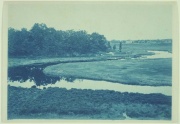Difference between revisions of "Cyanotype"
(username removed) |
m (Text replace - "== Authority ==" to "== Sources Checked for Data in Record ==") |
||
| (2 intermediate revisions by 2 users not shown) | |||
| Line 2: | Line 2: | ||
== Description == | == Description == | ||
| − | A blue printed image prepared by a nonsilver process that was popular for photographs at the end of the 19th century. More recently, cyanotypes, or blueprints, were primarily used to copy architectural drawings. The cyanotype method was suggested in 1842 by British astronomer Sir John Herschel but not widely used until the 1880s after Henri Pellet developed a direct positive blueprint process (1877). In this process, cyanotype paper is coated with a ferric and an organic acid in a binder ([ | + | A blue printed image prepared by a nonsilver process that was popular for photographs at the end of the 19th century. More recently, cyanotypes, or blueprints, were primarily used to copy architectural drawings. The cyanotype method was suggested in 1842 by British astronomer Sir John Herschel but not widely used until the 1880s after Henri Pellet developed a direct positive blueprint process (1877). In this process, cyanotype paper is coated with a ferric and an organic acid in a binder ([[dextrin|dextrin]], [[gum|gum]], or [[gelatin|gelatin]]); after exposure to light the image is developed with potassium ferricyanide which reacts to form [[Prussian%20blue|Prussian blue]]. The blue image on white paper is fixed by washing the remaining salts away in an aqueous solution. |
[[File:1986.593-SC25765.jpg|thumb|'''MFA Acc. #:''' 1986.593]] | [[File:1986.593-SC25765.jpg|thumb|'''MFA Acc. #:''' 1986.593]] | ||
| + | |||
== Synonyms and Related Terms == | == Synonyms and Related Terms == | ||
| Line 17: | Line 18: | ||
== Additional Information == | == Additional Information == | ||
| − | Alternative Photography: [http://www.alternativephotography.com/ | + | Alternative Photography: [http://www.alternativephotography.com/wp/history/cyanotype-history-john-herschels-invention] |
== Additional Images == | == Additional Images == | ||
| Line 35: | Line 36: | ||
| − | == | + | == Sources Checked for Data in Record == |
* ''Encyclopedia Britannica'', http://www.britannica.com Comment: "Blueprint." Encyclopædia Britannica. 2004. Encyclopædia Britannica Premium Service. 29 Apr. 2004 . | * ''Encyclopedia Britannica'', http://www.britannica.com Comment: "Blueprint." Encyclopædia Britannica. 2004. Encyclopædia Britannica Premium Service. 29 Apr. 2004 . | ||
Revision as of 20:18, 30 April 2016
Description
A blue printed image prepared by a nonsilver process that was popular for photographs at the end of the 19th century. More recently, cyanotypes, or blueprints, were primarily used to copy architectural drawings. The cyanotype method was suggested in 1842 by British astronomer Sir John Herschel but not widely used until the 1880s after Henri Pellet developed a direct positive blueprint process (1877). In this process, cyanotype paper is coated with a ferric and an organic acid in a binder (Dextrin, Gum, or Gelatin); after exposure to light the image is developed with potassium ferricyanide which reacts to form Prussian blue. The blue image on white paper is fixed by washing the remaining salts away in an aqueous solution.
Synonyms and Related Terms
blueprint; blue print; Prussian-blue process; Pellet process; pelletones
Hazards and Safety
Highly sensitive to alkalis. Should not contact buffered paper.
Additional Information
Alternative Photography: [1]
Additional Images
Sources Checked for Data in Record
- Encyclopedia Britannica, http://www.britannica.com Comment: "Blueprint." Encyclopædia Britannica. 2004. Encyclopædia Britannica Premium Service. 29 Apr. 2004 .
- Website address 2 Comment: Alternative Photography at http://www.alternativephotography.com/articles/art007.html
- The Dictionary of Art, Grove's Dictionaries Inc., New York, 1996 Comment: "Photography"
- Luis Nadeau, Encyclopedia of Printing, Photographic, and Photomechanical Processes, Atelier, New Brunswick, 1997
- Caring for your Collections, Arthur W Schulz (ed.), Harry N. Abrams, Inc. , New York, 1992
- Website address 1 Comment: AMOL reCollections Glossary - http://amol.org.au/recollections/7/c/htm
- Random House, Webster's Encyclopedic Unabridged Dictionary of the English Language, Grammercy Book, New York, 1997
- The American Heritage Dictionary or Encarta, via Microsoft Bookshelf 98, Microsoft Corp., 1998












